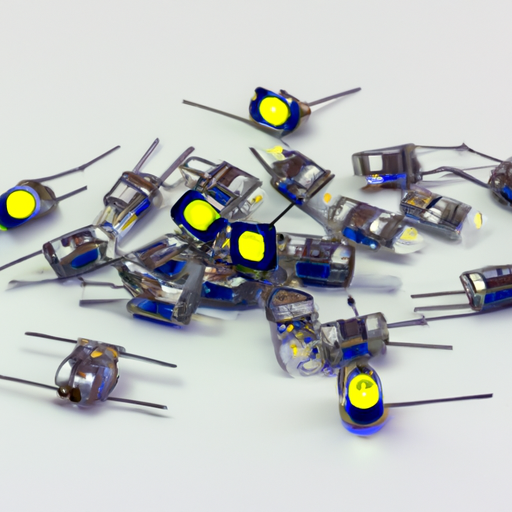LED emitters have transformed numerous industries by providing efficient and versatile lighting solutions. Below, we delve deeper into the core functional technologies, notable articles, and application development cases for infrared (IR), ultraviolet (UV), and visible light LED emitters.
| Wavelength Range: IR LEDs operate within the 700 nm to 1 mm range, making them suitable for various applications that require non-visible light.Wavelength Range: IR LEDs operate within the 700 nm to 1 mm range, making them suitable for various applications that require non-visible light. |
| Modulation Techniques: These LEDs can be modulated for data transmission, enabling applications in remote controls and optical communication systems.Modulation Techniques: These LEDs can be modulated for data transmission, enabling applications in remote controls and optical communication systems. |
| Photodetector Compatibility: IR LEDs are often paired with photodetectors like photodiodes, enhancing their effectiveness in signal detection.Photodetector Compatibility: IR LEDs are often paired with photodetectors like photodiodes, enhancing their effectiveness in signal detection. |
| Remote Control Systems: IR LEDs are ubiquitous in consumer electronics, allowing devices like TVs and air conditioners to be controlled from a distance.Remote Control Systems: IR LEDs are ubiquitous in consumer electronics, allowing devices like TVs and air conditioners to be controlled from a distance. |
| Night Vision Cameras: In security applications, IR LEDs provide illumination in darkness, enabling cameras to capture clear images without visible light.Night Vision Cameras: In security applications, IR LEDs provide illumination in darkness, enabling cameras to capture clear images without visible light. |
| Gesture Recognition: Devices that utilize IR LEDs for gesture recognition enhance user interaction, particularly in smart home devices and gaming consoles.Gesture Recognition: Devices that utilize IR LEDs for gesture recognition enhance user interaction, particularly in smart home devices and gaming consoles. |
| Wavelength Range: UV LEDs emit light from 100 nm to 400 nm, categorized into UV-A, UV-B, and UV-C, each with distinct applications.Wavelength Range: UV LEDs emit light from 100 nm to 400 nm, categorized into UV-A, UV-B, and UV-C, each with distinct applications. |
| Disinfection and Sterilization: UV-C LEDs are particularly effective in germicidal applications, capable of inactivating bacteria and viruses.Disinfection and Sterilization: UV-C LEDs are particularly effective in germicidal applications, capable of inactivating bacteria and viruses. |
| Photopolymerization: These LEDs are essential in curing processes for inks, coatings, and adhesives, providing rapid solidification.Photopolymerization: These LEDs are essential in curing processes for inks, coatings, and adhesives, providing rapid solidification. |
| Water Purification: UV LEDs are increasingly used in water treatment systems, effectively eliminating pathogens without chemical additives.Water Purification: UV LEDs are increasingly used in water treatment systems, effectively eliminating pathogens without chemical additives. |
| Medical Sterilization: Hospitals utilize UV-C LEDs for sterilizing surfaces and medical equipment, significantly reducing infection rates.Medical Sterilization: Hospitals utilize UV-C LEDs for sterilizing surfaces and medical equipment, significantly reducing infection rates. |
| Curing Applications: In the printing and manufacturing industries, UV LEDs facilitate rapid curing of inks and coatings, enhancing production efficiency.Curing Applications: In the printing and manufacturing industries, UV LEDs facilitate rapid curing of inks and coatings, enhancing production efficiency. |
| Color Spectrum: Visible LEDs emit light in the 400 nm to 700 nm range, covering the entire spectrum from violet to red.Color Spectrum: Visible LEDs emit light in the 400 nm to 700 nm range, covering the entire spectrum from violet to red. |
| Energy Efficiency: Compared to traditional incandescent bulbs, visible LEDs offer superior energy efficiency and longer lifespans.Energy Efficiency: Compared to traditional incandescent bulbs, visible LEDs offer superior energy efficiency and longer lifespans. |
| Dimming and Color Tuning: Advanced visible LEDs allow for dimming and color tuning, enabling dynamic and customizable lighting solutions.Dimming and Color Tuning: Advanced visible LEDs allow for dimming and color tuning, enabling dynamic and customizable lighting solutions. |
| General Lighting: Visible LEDs are widely adopted in residential, commercial, and industrial lighting due to their energy efficiency and longevity.General Lighting: Visible LEDs are widely adopted in residential, commercial, and industrial lighting due to their energy efficiency and longevity. |
| Display Technology: LEDs are integral to modern display technologies, including televisions, monitors, and smartphones, providing vibrant colors and high contrast.Display Technology: LEDs are integral to modern display technologies, including televisions, monitors, and smartphones, providing vibrant colors and high contrast. |
| Smart Lighting Solutions: Visible LEDs are utilized in smart lighting systems that can be controlled via mobile apps, allowing users to customize their lighting environments.Smart Lighting Solutions: Visible LEDs are utilized in smart lighting systems that can be controlled via mobile apps, allowing users to customize their lighting environments. |
LED emitters across the infrared, ultraviolet, and visible spectrums have significantly impacted various sectors by providing efficient, reliable, and versatile lighting solutions. Their applications range from everyday consumer products to critical medical and industrial processes. As technology continues to evolve, we can expect further innovations and applications in LED technology, enhancing their role in our daily lives.
For further exploration, consider accessing articles from reputable sources such as IEEE Xplore, ScienceDirect, and industry-specific journals that focus on advancements in LED technology and its applications.



















